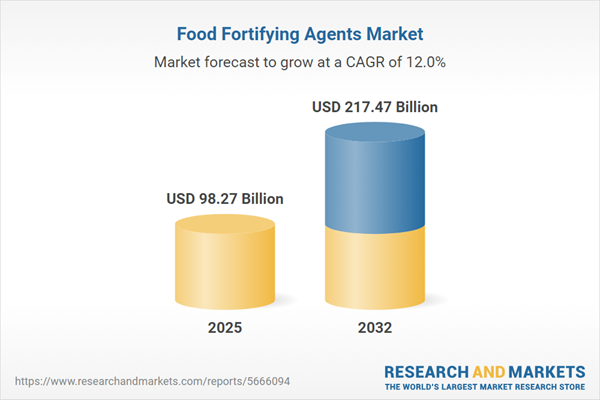Speak directly to the analyst to clarify any post sales queries you may have.
Senior leaders navigating the food fortifying agents market contend with evolving consumer health priorities, swift regulatory adjustments, and increasing demands for sustainable business practices. This dynamic sector requires clear, actionable insights to help organizations anticipate challenges and capitalize on emerging opportunities.
Food Fortifying Agents Market Snapshot
The global food fortifying agents market is in a phase of rapid expansion, propelled by growing consumer demand for products that support health and wellbeing. This trend is influencing companies to innovate in nutrient delivery systems and invest in novel formulation strategies. Emphasis on responsible sourcing, operational efficiency, and transparent supply chains is reshaping the market’s approach to competition and innovation. The integration of digital supply chain technologies and the proliferation of strategic alliances across the value chain underscore the sector’s growing complexity, opening avenues for both established players and market newcomers.
Scope & Segmentation in the Food Fortifying Agents Market
This comprehensive report provides a clear framework to help organizations make informed strategic decisions and mitigate risks through detailed analysis of pivotal market segments:
- Nutrient Types: Encompasses amino acids essential for protein retention, antioxidant carotenoids, food processing enzymes, varied mineral supplements, a breadth of probiotics such as beneficial yeasts and bacteria, and an inclusive range of water- and fat-soluble vitamins, facilitating alignment with consumer health trends.
- Applications: Includes animal feed fortification for segments like poultry, aquaculture, ruminants, and swine, as well as enrichment of products across bakery, confectionery, dairy, functional beverages, dietary supplements, and targeted infant nutrition to support tailored strategies by vertical.
- Formulations: Covers a broad spectrum of delivery methods—coated and standard granules, ready-to-use liquids, emulsions, pellets, and powders produced via micronization, spray-drying, or freeze-drying—ensuring adaptability in R&D and manufacturing.
- Distribution Channels: Examines pathways such as direct partnerships with manufacturers, traditional feed distribution, B2B e-commerce, pharmacy networks, specialty retail, and supermarket channels, supporting robust go-to-market strategies.
- Geographic Regions: Considers activity across the Americas (United States, Canada, Brazil), Europe, the Middle East and Africa (UK, Germany, UAE, Nigeria), and Asia-Pacific (China, India, Japan, Australia), enabling stakeholders to address nuanced regional regulations and diverse consumer demands.
- Key Companies: Highlights leaders like Koninklijke DSM N.V., BASF SE, Archer Daniels Midland, DuPont de Nemours, Cargill, Lonza, Kerry Group, Glanbia, Associated British Foods, and Merck KGaA, providing reference points for best practices in innovation and compliance.
Key Takeaways for Senior Decision-Makers
- Agility in aligning compliance with emerging regulatory health guidance strengthens organizational credibility and underpins sustainable market growth.
- Adoption of advanced nutrient delivery, including microencapsulation, supports distinct product positioning and facilitates entry into emerging consumer demographics.
- Diversifying product portfolios and leveraging transparent labeling enable broader demographic engagement and swift adaptation to shifting regional preferences.
- Ongoing commitment to ethical sourcing and enhanced digital traceability increases supply chain transparency, builds supplier trust, and bolsters brand reputation.
- Collaboration with technology providers accelerates the innovation cycle and helps streamline product commercialization and market responsiveness.
- Investments in circular economy projects and operational efficiency contribute to resource optimization, adaptability, and stronger environmental stewardship.
Tariff Impact: United States Policy Changes for 2025
Impending tariff policy changes in the United States for 2025 will reshape import costs for the food fortifying agents sector. Industry leaders are responding by boosting local sourcing, enhancing regional processing capacity, and strengthening cross-supply chain partnerships to sustain reliable product access as trade frameworks evolve.
Methodology & Data Sources
This analysis relies on a combination of qualitative and quantitative research techniques. Insights were derived from interviews with senior executives, technical and regulatory experts. Findings have been validated against peer-reviewed studies, official regulatory documentation, patent analysis, detailed trade reports, and commercial data sets.
Why This Report Matters
- Empowers senior executives to recognize strategic opportunities and prioritize investments that support sustainable expansion in the food fortifying agents market.
- Clarifies how technology advancements and regulatory shifts reshape partnerships, commercialization, and entry strategies.
- Enables organizations to anticipate compliance changes and respond promptly to international trade fluctuations, ensuring continued market leadership.
Conclusion
Applying the insights from this report helps decision-makers enhance organizational agility and navigate the complex food fortifying agents market, laying a foundation for informed, sustainable growth strategies.
Additional Product Information:
- Purchase of this report includes 1 year online access with quarterly updates.
- This report can be updated on request. Please contact our Customer Experience team using the Ask a Question widget on our website.
Table of Contents
3. Executive Summary
4. Market Overview
7. Cumulative Impact of Artificial Intelligence 2025
Companies Mentioned
The companies profiled in this Food Fortifying Agents market report include:- Koninklijke DSM N.V.
- BASF SE
- Archer Daniels Midland Company
- DuPont de Nemours, Inc.
- Cargill, Incorporated
- Lonza Group AG
- Kerry Group plc
- Glanbia plc
- Associated British Foods plc
- Merck KGaA
Table Information
| Report Attribute | Details |
|---|---|
| No. of Pages | 185 |
| Published | October 2025 |
| Forecast Period | 2025 - 2032 |
| Estimated Market Value ( USD | $ 98.27 Billion |
| Forecasted Market Value ( USD | $ 217.47 Billion |
| Compound Annual Growth Rate | 12.0% |
| Regions Covered | Global |
| No. of Companies Mentioned | 11 |









